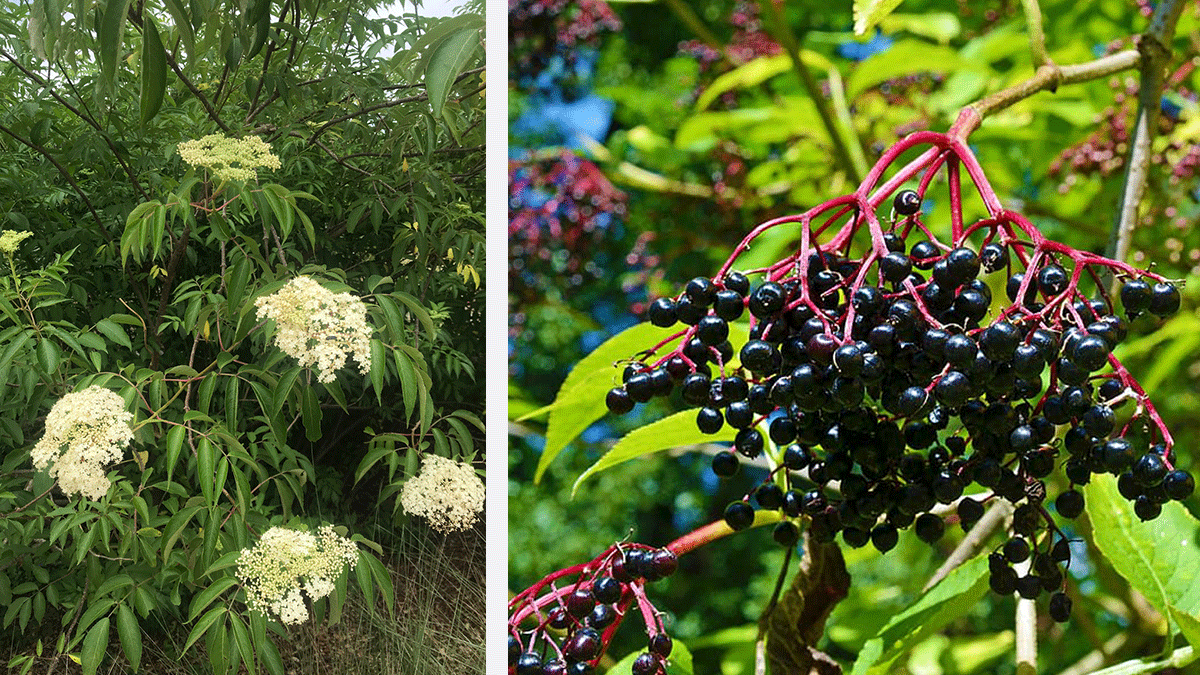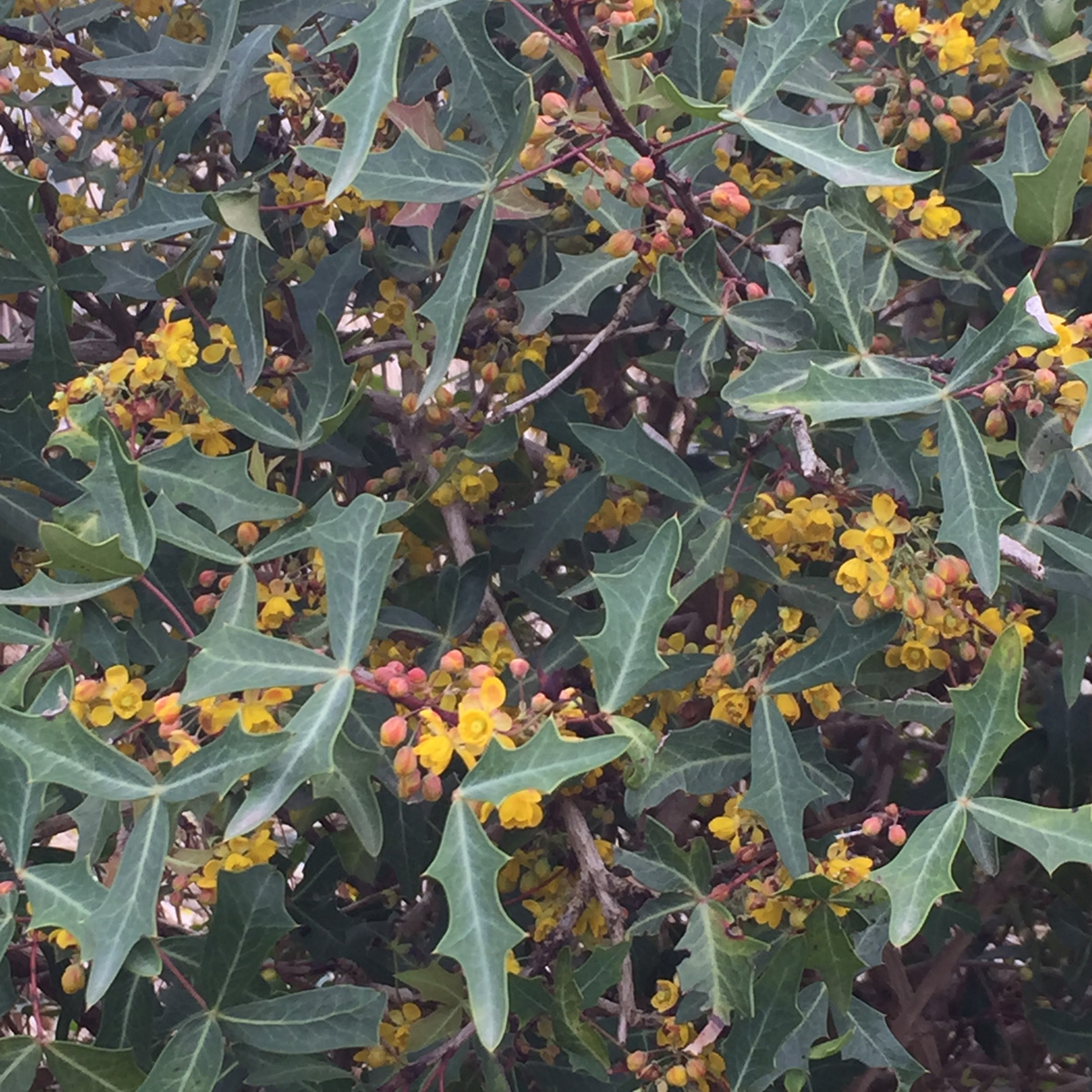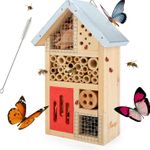
The Southern Plains is home to several plant species with edible and delicious fruits. Some, such as plums and grapes, receive a lot of attention for their long history of being eaten by humans. I’ve chosen a few lesser known but equally delicious species to profile here.

Elderberry
Common elderberry (Sambucus nigra ssp. canadensis, Zones 3–9) is a perennial shrub that grows to about 12 feet in height in moist areas such as ditches, bogs, and riparian thickets. It is native to all of the lower 48 states and is generally found in partial shade but will also thrive in full sun given adequate moisture.
Elderberry produces clusters of deep purplish-black berries that are loaded with vitamins, minerals, and antioxidants. The tiny berries are often used to make jellies, jams, and an old-time favorite—elderberry wine. The berries are also thought to have immune-boosting properties, and so many folks harvest them for medicinal use. Elderberry has an uneven season of flowering (and therefore fruit production) over several months, usually from May through July in the Southern Plains. This means you will often find new flowers, unripe fruits, and ripe fruits on the same plant at the same time. Unripe fruits—as well as the leaves, roots, and stems—are mildly toxic, so be sure to harvest only ripe fruits. Ripe clusters of elderberries are dark purplish-black and heavy, often causing the whole cluster to hang upside down. In contrast, green and unripe fruits are held upright.
Here are a couple of important tips for harvesting elderberries: First, you have to beat the birds to them. The berries are only about 3/16 to 1/4 inch in diameter and are beloved by birds, so check your elderberry plants often for ripe clusters! Second, you must process your harvested berries within 12 hours of picking them because they begin to ferment right away. That is exactly why you never see elderberries offered at farmers’ markets or at grocery stores; they are simply too perishable to be marketed fresh. This lack of commercial availability is a great reason to grow your own elderberry shrub!

Agarita
Agarita, also known as wild currant or desert holly (Mahonia trifoliolata, Zones 7–9), is a delightful, albeit thorny, evergreen shrub. Growing to about 3 to 6 feet in height, agarita has holly-like trifoliate leaves, with each leaf lobe ending in sharp spines. It has the capacity to form thorny thickets and thrives in the droughty Texas Hill Country and in South Texas. Agarita prefers full sun or at least partial shade and does fine in poor soils, although it needs to be well-drained. It requires little water and is very drought tolerant. You can plant it in a forgotten corner and, as long as it is relatively sunny and not too wet, it will do just fine. Despite its thorny foliage, agarita has several things going for it. Its gray-green to gray-blue foliage is beautiful and distinctive. The flowers, which appear in February or March, are bright yellow and smell strongly of honey. The smell is so strong that I have very often located a plant by smell alone. The fruits, which are small red berries, appear in May through July and are deliciously tart and sweet. I am a fan of eating them from my hand with no further preparations, but many folks turn them into jams, jellies, juices, and even wine. The trick to harvesting these tasty berries is in avoiding agarita’s thorns. You can spread a blanket, tarp, or umbrella under the bush and then strike it with a stick to make the ripe berries fall. From there, simply gather up your blanket and pour the berries into a bag or jar. This is another fruit that you won’t find sold fresh at local markets, so it’s fun to grow on your own.

Fragrant sumac
Fragrant sumac (Rhus aromatica, Zones 3–9) is a perennial shrub found throughout the Southern Plains in old fields and open woods. It’s a very easy-care plant for a home landscape, tolerating full sun or partial shade and requiring little water. It reaches about 3 to 6 feet in height and has glossy trifoliate leaves that turn shades of red and yellow in fall. The yellow catkin flowers are fairly inconspicuous and appear at the tips of branches before leaves appear in early spring. Female flowers produce clusters of red berries in May. The berries are sticky and covered in tiny downy hairs. My favorite use of the fruit is to make a slightly sour sumac-ade. Just pick enough berries to fill your glass or pitcher by about one-fourth, and then fill the rest of the container with warm water. The sour citric acid taste will permeate the drink and give it a delightful pucker, much like lemonade.
Each of these Southern Plains species warrants inclusion in gardens and home landscapes independent of their edible status, but their delicious fruits make them even more fun to grow. If you’re lucky, you may even find some wild specimens at fruiting time and be able to do some harvesting!
—Karen Beaty is a horticulturalist at the Lady Bird Johnson Wildflower Center in Austin, Texas.
Fine Gardening Recommended Products

A.M. Leonard Deluxe Soil Knife & Leather Sheath Combo
Fine Gardening receives a commission for items purchased through links on this site, including Amazon Associates and other affiliate advertising programs.

Chapin International 10509 Upside-Down Trigger Sprayer
Fine Gardening receives a commission for items purchased through links on this site, including Amazon Associates and other affiliate advertising programs.

Niteangel Natural Wooden Insect Hotel, Garden Insect House for Ladybugs, lacewings, Butterfly, Bee, Bug
Fine Gardening receives a commission for items purchased through links on this site, including Amazon Associates and other affiliate advertising programs.



















Comments
Log in or create an account to post a comment.
Sign up Log in